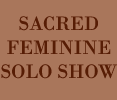
|
||
|
||
Self-Portrait with Horse and Skeleton
finds me flanked by a horse (life) and a skeleton (death). I had a
comforting dream in which a horse I were friends, we spoke with each
other; the horse was a protector and guide for me.
In my studio I often work on two pieces simultaneously. I started Self Portrait with Horse and Skeleton along with Self Portrait with Mirror Image of Death, with Church Window. As I was working on these pieces I realized that they were in dialogue with each other. The first part of the narrative, illustrated by Self-Portrait with Horse and Skeleton, images me shunning death and choosing life. Self Portrait with Mirror Image of Death, with Church Window illustrates what happens when I reach the end of what I am actively able to do to help myself live. I surrender to the mystery of life and death which is mediated by the transcendent power of the Divine: the church window. I used the whiplash line, found in the lines of a snake’s body and the Art Nouveau movement because it has motion that is snappy and dynamic and one can hear in their mind the crack of a whip. A curvilinear line, especially a spiral, and used in some of today’s goddess art, can feel trite and overly feminine. The spiral seems predictable and monotonous; one knows where it starts, and where it will end. Sometimes, as I draw or sculpt, I alternate between straight and sinuous lines. This blend of geometric and curved lines reinforces the balance I strive to create between masculine and feminine in my work with regards to content and form. I wonder if the brain processes straight and curved lines differently. Are straight lines processed by the left brain and curved lines by the right? I am not attracted works of art that are strictly geometric; they are too conformist, lacking imagination. Likewise, overly swirly lines feel sugary and lack a backbone. One of my favorite artists is Bob Dylan because his yearning and tender moments are balanced by defiance. I made one side of the horse’s face rough, the side that is near the skeleton. Conversely, I made the side of the horse’s face that is nearest to me smooth and soft. The roughness speaks to dynamic energy that is ready to spring forth and fight. The smoothness evokes softness; the sunlight is caressing the figures. There was a period of time I could not work on this piece, yet I had to spray it down with water to keep it moist. And, over the weeks, the image of the figure became fixed in my mind; I had to destroy that fixed image in my mind by just adding something, anything, and subtract something, anything to disrupt the fixed image of it in my mind and to have some spontaneous and unexpected ideas flow in as possibilities. While making Self-Portrait with Horse and Skeleton, I tacked up pictures by Thomas Hart Benton to my studio wall. The swirling flux and sculptural forms in his work resonate with me; the grass is alive, the clouds are alive; each element has a consciousness about it. Using different points of perspective, the figures look like they belong in different worlds that have intersected, adding to the heightened motion. I also referenced Oskar Kokoschka’s The Bride of the Wind because of his use of motion. |
||





